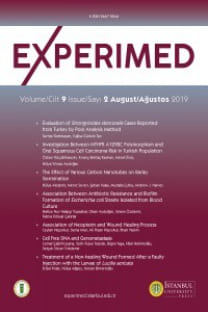Caspase-9 rs1052576 Polymorphism is not Associated with Glioblastoma in Turkish Patients
Caspase-9 rs1052576 Polymorphism is not Associated with Glioblastoma in Turkish Patients
Caspase9, Glioblastoma, Polymorphism, rs1052576,
___
- 1. Ostrom QT, Patil N, Cioffi G, Waite K, Kruchko C, Barnholtz-Sloan JS. CBTRUS Statistical report: primary brain and other central nervous system tumors diagnosed in the United States in 20132017 Neuro Oncol 2020; 22(12 Suppl 2): iv1-iv96. [CrossRef] google scholar
- 2. Ostrom QT, Gittleman H, Farah P, Ondracek A, Chen Y, Wolinsky Y, et al. CBTRUS statistical report: primary brain and central nervous system tumors diagnosed in the United States in 2012-2016. Neuro Oncol 2019; 25(S5): 1-100. [CrossRef] google scholar
- 3. Hanif F, Muzaffar K, Perveen K, Malhi SM, Simjee ShU. Glioblastoma multiforme. A review of its epidemiology and pathogenesis through clinical presentation and treatment. Asian Pac J Cancer Prev 1 2017; 18(1): 3-9. google scholar
- 4. D'Alessio A, Proietti G, Sica G, Scicchitano BM. Pathological and molecular features of glioblastoma and its peritumoral tissue. Cancers (Basel) 2019; 11(4): 469. [CrossRef] google scholar
- 5. Crespo I, Vital AL, Gonzalez-Tablas M, Patino Mdel C, Otero A, Lopes MC, de Oliveira C, Domingues P, et al. Molecular and genomic alterations in glioblastoma multiforme. Am J Pathol 2015; 185(7):1820-33. [CrossRef] google scholar
- 6. Haque A, Banik NL, Ray SK. Molecular alterations in glioblastoma: Potential targets for immunotherapy. Prog Mol Biol Transl Sci 2011; 98: 187-234. [CrossRef] google scholar
- 7. Valdes-Rives SA, Casique-Aguirre D, German-Castelan L, Velasco-Velazquez MA, Gonzalez-Arenas A. Apoptotic signaling pathways in glioblastoma and therapeutic implications. Biomed Res Int 2017; 7403747. [CrossRef] google scholar
- 8. Olsson M, Zhivotovsky B. Caspases and cancer. Cell Death Differ 2011; 18(9): 1441-9. [CrossRef] google scholar
- 9. McIlwain DR, Berger T, Mak TW. Caspase functions in cell death and disease. Cold Spring Harb Perspect Biol 2013; 5(4): a008656. [CrossRef] google scholar
- 10. Mohammad RM, Muqbil I, Lowe L, Yedjou C, Hsu HY, Lin LT, et al. Broad targeting of resistance to apoptosis in cancer. Semin Cancer Biol 2015; 35 Suppl(0): S78-S103. [CrossRef] google scholar
- 11. Avrutsky MI, Troy CM. Caspase-9. A multimodal therapeutic target with diverse cellular expression in human disease. Front Pharmacol 2021; 12: 701301. [CrossRef] google scholar
- 12. Abel F, Sjöberg RM, Ejeskar K, Krona C, Martinsson T. Analyses of apoptotic regulators CASP9 and DFFA at 1P36.2, reveal rare allele variants in human neuroblastoma tumours. Br J Cancer 2002; 86(4): 596-604. [CrossRef] google scholar
- 13. National Library of Medicine, NCBI Databases. Available from: URL: // www.ncbi.nlm.nih.gov/pubmed/?term=caspase+9+polymorphism google scholar
- 14. Xu W, Jiang S, Xu Y, Chen B, Li Y, Zong F, et al. A meta-analysis of caspase 9 polymorphisms in promoter and exon sequence on cancer susceptibility. PLoS One 2012; 7(5): e37443. [CrossRef] google scholar
- 15. Hirano A, Nagai H, Harada H, Haga S, Kajiwara T, Emi M. Two novel single-nucleotide polymorphisms of the Caspase-9 (CASP9) gene in the Japanese population. Genes Immun 2001; 2(2): 117-8. [CrossRef] google scholar
- 16. Andreoli V, Trecroci F, La Russa A, Valentino P, Condino F, Latorre V et al. CASP-9. A susceptibility locus for multiple sclerosis in Italy. J Neuroimmunol 2009; 210(1-2): 100-3. [CrossRef] google scholar
- 17. Hosgood HD 3rd, Baris D, Zhang Y, Zhu Y, Zheng T, Yeager M, et al. Caspase polymorphisms and genetic susceptibility to multiple myeloma. Hematol Oncol 2008; 26(3): 148-51. [CrossRef] google scholar
- 18. Lan Q, Zheng T, Chanock S, Zhang Y, Shen M, Wang SS, et al. Genetic variants in caspase genes and susceptibility to non-Hodgkin lymphoma. Carcinogenesis 2007; 28(4): 823-7. [CrossRef] google scholar
- 19. Zhang ZY, Xuan Y, Jin XY, Tian X, Wu R. CASP-9 gene functional polymorphisms and cancer risk: a large-scale association study plus meta-analysis. Genet Mol Res 2013; 12(3): 3070-8. [CrossRef] google scholar
- 20. Yan S, Li YZ, Zhu XW, Liu CL, Wang P, Liu YL. Role of the CASP-9 Ex5+32 G>A polymorphism in susceptibility to cancer: A meta-analysis. Exp Ther Med 2013; 5(1): 175-80. [CrossRef] google scholar
- 21. Ozdogan S, Kafadar A, Yilmaz SG, Timirci-Kahraman O, Gormus U, Isbir T. Role of Caspase-9 Gene Ex5+32 G>A (rs1052576) variant in susceptibility to primary brain tumors. Anticancer Res 2017; 37(9): 4997-5000. [CrossRef] google scholar
- Yayın Aralığı: Yılda 3 Sayı
- Başlangıç: 2011
- Yayıncı: İstanbul Üniversitesi
Activation-Induced Cytidine Deaminase Expression in Patients with Chronic Myeloid Leukemia
Emin OGUZ, Aynur DAĞLAR ADAY, Akif Selim YAVUZ
Assessing E-Cadherin and Connexin 43 Gene Expressions in Colorectal Cancer
Saime SÜRMEN, Soykan ARIKAN, Özlem TİMİRCİ KAHRAMAN, Mustafa Gani SÜRMEN, Canan CACINA, İlhan YAYLIM
Melis KARTAL YANDIM, Mesut BİLGİN
A Histological Evaluation of the Effect of Ghrelin on Wound Healing in Rats
Esin AK, Kerime ULUSOY-DAG, Feriha ERCAN, Ahmet CORAK
Miray ATACAN YAŞGÜÇLÜKAL, Zeynep ACAR, Birgül BAŞTAN, Aytül MUTLU, Özlem ÇOKAR
Clues to the Harmful Effects of Aspartame on Liver Morphology and Function
Emine Rümeysa HEKİMOĞLU, Birsen ELİBOL, Ceyhun TORUNTAY, Seda KIRMIZIKAN, Ozge PASİN, Ufuk SARIKAYA, Damla ALKHALİDİ, Mukaddes EŞREFOĞLU
Çağatay AK, Süleyman SAYAR, Resul KAHRAMAN, Kamil OZDİL
Sümeyye YILMAZ, Elif TUFAN, Güzin Göksun SİVAS, Begüm GÜREL GÖKMEN, Ercan DURSUN, Dilek ÖZBEYLİ, Göksel ŞENER, Tuğba TUNALI-AKBAY
Ilknur DURSUN, Birsen ELİBOL, Ebru HACIOSMANOĞLU, Havva (ewa) DOĞRU
Germline Screening of Cancer-Related Genes in Turkish Ovarian Cancer Patients
Esra ARSLAN ATEŞ, Ceren ALAVANDA, Bilgen Bilge GEÇKİNLİ, İlter GÜNEY, Tuba GUNEL
